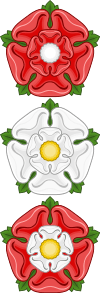Second Cornish uprising of 1497
The Second Cornish uprising is the name given to the Cornish uprising of September 1497 when the pretender to the throne Perkin Warbeck landed at Whitesand Bay, near Land's End, on 7 September with just 120 men in two ships.
| Second Cornish uprising of 1497 | |||||||
|---|---|---|---|---|---|---|---|
| |||||||
| Belligerents | |||||||
|
|
| ||||||
| Commanders and leaders | |||||||
|
Perkin Warbeck |
Henry VII Giles, Lord Daubeney | ||||||
| Strength | |||||||
| 2 ships, 120 men, 6,000 Cornish army | King's Scouts | ||||||
Warbeck had seen the potential of the Cornish unrest in the 1st Cornish Rebellion of 1497 even though the Cornish had been defeated at the Battle of Deptford Bridge on 17 June 1497. Warbeck proclaimed that he would put a stop to extortionate taxes levied to help fight a war against Scotland and was warmly welcomed in Cornwall. His wife, Lady Catharine, was left in the safety of St Michael's Mount and when he decided to attack Exeter his supporters declared him ‘Richard IV’ on Bodmin Moor.[1] Most of the Cornish gentry supported Warbeck's cause after their setback previously in June of that year and on 17 September a Cornish army some 6,000 strong entered Exeter, where the walls were badly damaged, before advancing on Taunton.[2]
Henry VII sent his chief general, Giles, Lord Daubeney, to attack the Cornish and when Warbeck heard that the King's scouts were at Glastonbury he panicked and deserted his army. Warbeck was captured at Beaulieu Abbey in Hampshire, where he surrendered. Henry VII reached Taunton on 4 October 1497, where he received the surrender of the remaining Cornish army. The ringleaders were executed and others fined an enormous total of £13,000. 'King Richard' was imprisoned, first, at Taunton, then in London, where he was ‘paraded through the streets on horseback amid much hooting and derision of the citizens’.[3] On 23 November 1499 Warbeck was drawn on a hurdle from the Tower to Tyburn, London, where he read out a ‘confession’ and was hanged.[4][5]
See also
References
- Cornwall timeline 1497 Archived September 30, 2007, at the Wayback Machine
- Cornwall, Philip Payton (1996), Fowey: Alexander Associates
- Channel 4 - Perkin Warbeck
- Perkin Warbeck Archived 2007-12-19 at the Wayback Machine
- Bodmin - Centre of three Cornish uprisings
